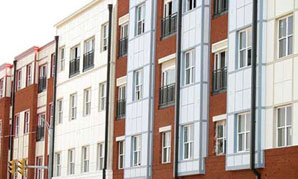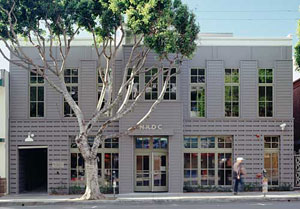Intrinsic Materials: Modernism, Sustainability and Fiber Cement Panels
Contemporary design − transitional and industrial applications
Not all contemporary designers are modernists. In fact, many clients resist designs that stray from familiar or historic styles. Transitional designs are often a solution for the client who wants a commercial building that is new, but also familiar. These projects often mix masonry with panels, providing a cost effective means for the designer to provide variety in form and texture.
Industrial and high-tech - exposing the connections
Inspired by the simplicity of industrial buildings, professionals are also designing to express and expose stuctural connections. Early attempts to show steel channel separations, the rebar in concrete, the nail heads in wood and the screw heads in metal plates, often led to staining and in some cases, material failures. This new fiber cement panel solution is designed to express the seams and joints as well as expose the fasteners to add to the visual awareness of the building's construction. The fasteners and trim are manufactured
in rust resistant aluminum and will not stain the cement panel surface.
Color
Although the early modernists like Mondrian and Rietveld limited their palettes to primary colors, subsequent designers revelled in color science as explored by Josef Albers. Today's theories on color include studies on the psychology of color expression. In the Seattle library, designed by Rem Koolhaas, color is used to direct circulation as well as behavior. Rich color palettes express both the culture and context by design. The fiber cement panel system with an expressed trim can be either factory finished or field
painted. Aluminum panel trims can be selected that are either a clear anodized finish or powder coated to match or contrast the fiber cement panel. Panels can be painted or pre-finished to any color although the architect needs to consider the climate zone for finish applications.
Mixed-use Complex - Norfolk, VA |
|
This mixed-use complex was designed and constructed around the shell of the building built in the 1940s as a Sears department store in Norfolk, Virginia. The complex includes 225 one- and two-bedroom luxury loft style apartment homes, over 15,600- square feet of retail space, as well as a parking garage, swimming pool and fitness center. This project demonstrates one designer's use of fiber ce-ment as a means to suggest a traditional window bay. Historically, this infill in a brick housing complex would have been constructed either in metal or stucco panels. John M. Jenkins, AIA, LEED AP, of The Lessard Group was in charge of this complex retrofit. |

Fiber cement panels with a powder-coated expressed aluminum seam were used to replicate a traditional bay window in this mixed-use complex. Photo courtesy of James Hardie |
Â
SUSTAINABILITY
Natural Resources Defense Council -
Robert Redford Building, |
|
Completed in 2003, the Natural Resources Defense Council mixed-use building complex in Santa Monica, California achieved a Platinum Rating from the USGBC's LEED® rating system. Designed by the architectural firm of Moule & Polyzoides, Architects and Urbanists, this project houses an interpretive center, commercial offices as well as retail businesses in downtown Santa Monica. The building is a complete renovaton of an existing downtown building. From an analysis of energy savings to a review of all of the material choices, the architects planned the renovation to integrate as many sustainable principles as possible. According to a well documented LEED® case study of the building,3 the project team had hoped to retain most of the original building but discovered that much of the frame was rotten and had to be replaced. All new wood used in the project came from certified forests and cladding materials were chosen for their low emissions and durability. As much as possible, alternative materials were selected as a substitute for wood. Fiber cement siding was chosen because of its durability and longevity. This material also could be obtained locally and would not succumb to rot or the salty air of the coastal climate. The building has recieved numerous awards and is a best practice model for sustainability. |

The Natural Resources Defense Council - Robert Redford Building is clad in durable fiber cement siding, that contributed to its LEED® Platinum rating. Photo: © Tim Street-Porter |
Â
Sustainability is often defined as the ability to meet the needs of the present generation without comprimising those of the next generation. The Committee on the Environment of the American Institute of Architects defines sustianability as follows:
"Sustainability envisions the enduring prosperity of all living things. Sustainable design seeks to create communities, buildings, and products that contribute to this vision."4
One of the top ten principles of sustainability listed by the AIA includes the concept of long life and loose fit. This principal can be applied to materials that increase the ecological, social and economic value over time. Fiber cement panels meet this requirement as they are durable, water proof, and provide some insulating values towards energy efficiency as a weather barrier. Fiber cement panels are strong, lighter than masonry, cost less to ship, are impact-and insect-resistant, as well as are manufactured from regional materials.
According to the AIA, "Sustainable design seeks to enhance and increase ecological, social, and economic values over time."5









